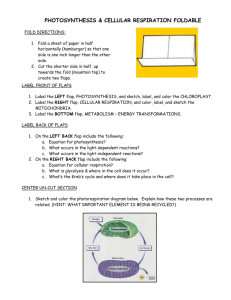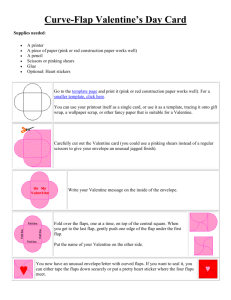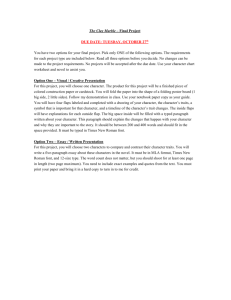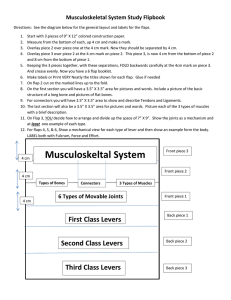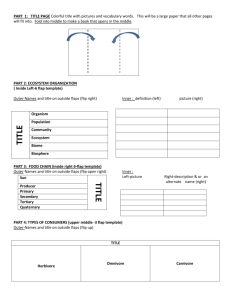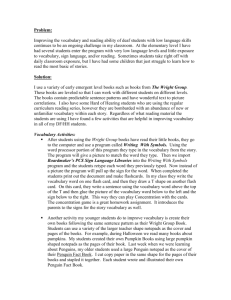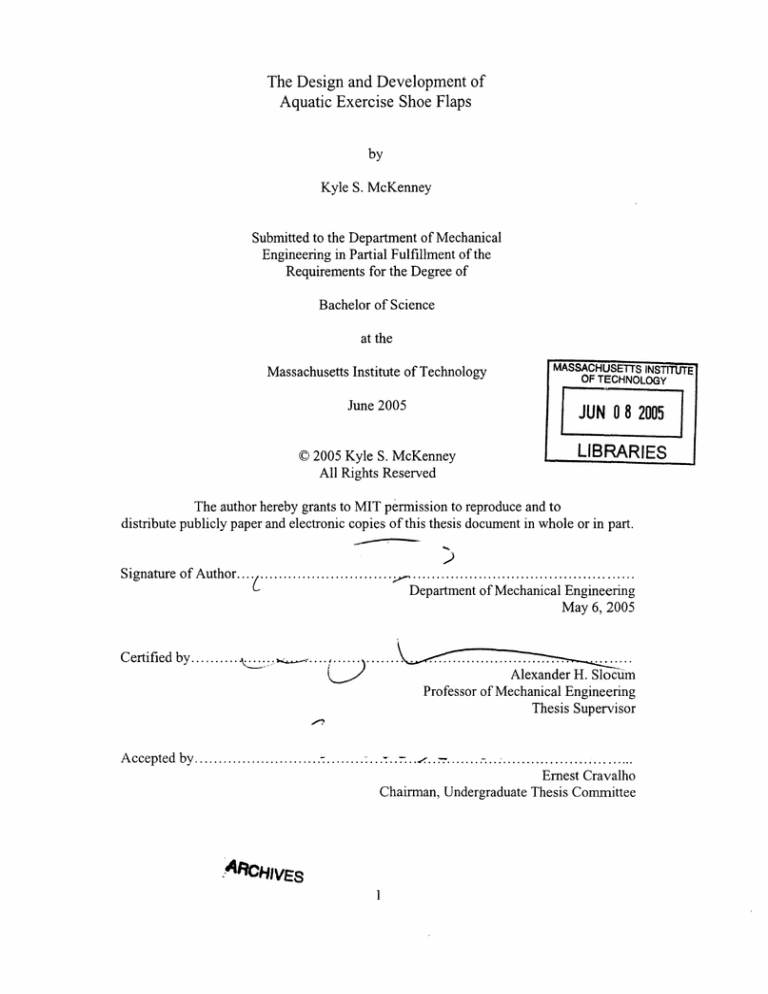
The Design and Development of
Aquatic Exercise Shoe Flaps
by
Kyle S. McKenney
Submitted to the Department of Mechanical
Engineering in Partial Fulfillment of the
Requirements for the Degree of
Bachelor of Science
at the
Massachusetts Institute of Technology
June 2005
MASSACHUSET' S INSlmJE
OF TECHNC )LOGY
JUN
0 8
2005ES
©(2005 Kyle S. McKenney
All Rights Reserved
LIBRAR tES
The author hereby grants to MIT permission to reproduce and to
distribute publicly paper and electronic copies of this thesis document in whole or in part.
)
Signature of Author .............
............................
Department of Mechanical Engineering
May 6, 2005
Certified
by ..........
... ,..
Accepted
by.
..........
.=-,
'
)
Alexander H. Slocum
Professor of Mechanical Engineering
Thesis Supervisor
..........................
.-.......
-.............
....... . ............................
Ernest Cravalho
Chairman, Undergraduate Thesis Committee
A-AfHIVES
1
The Design and Development of
Aquatic Exercise Shoe Flaps
by
Kyle S. McKenney
Submitted to the Department of Mechanical Engineering
on May 6, 2005 in partial fulfillment of the
Requirements for the Degree of Bachelor of Science in
Mechanical Engineering
ABSTRACT
A foam structure that is attached to the bottom of a shoe worn while exercising in the
water was designed, developed, and prototyped. The structure freely bends downward so
as to provide little resistance when the foot is raised, but is resistant to bending upward
when the foot is pressed down, thereby increasing resistance and enhancing the in-water
exercise effect. The structure is called AquaFlaps.
Several sketch models were made in the development of the idea leading to several foam
prototypes created using the water jet. Testing of these models and prototypes yielded
useful data which helped towards the final design. Testing also demonstrated that the
product achieves the desired results. A provisional patent was filed.
Thesis Supervisor: Alexander H. Slocum
Title: Professor of Mechanical Engineering
2
Table of Contents
1.0 Introduction ..........................................................................................
4
1.1 Background and Objective ..................................................................
4
1.2 Physical Intelligence Dimension ............................................................
5
2.0 Apparatus ..........................................................................................
6
2.1 Thought and Design Process ................................................................
6
2.1a Sketch Models ...........................................................................
7
2. lb Materials Selection .....................................................................
12
2.2 Prototyping ...................................................................................
13
2.2a The Flaps ................................................................................
15
2.2b The Pin ..................................................................................
18
2.3 the Final Design .............................................................................
20
2.4 Recommendations for Further Designing ................................................
23
3.0 Future .............................................................................................
23
3.1 Market ........................................................................................
23
3.2 Production and Packaging ..................................................................
24
4.0 Conclusions ......................................................................................
25
Appendix A - Original Thesis Proposal ..........................................................
26
Appendix B - Outside Contributors ..............................................................
27
Appendix C - Final Design Specifications ......................................................
27
Appendix D - Technology Disclosure ............................................................
29
Appendix E - Provisional Patent ..................................................................
32
3
1.0 Introduction
1.1 Background and Objective
Athletic training is a concept that has been known to man for centuries. It began simply
with the lifting of heavy objects as well as with walking and running. It has since
evolved, allowing for athletic training far beyond what could have been done twenty or
thirty years ago. There are machines and exercises in existence today for almost anything
imaginable. Despite these technological improvements made to the fitness world, there is
still an incredible potential for exercises to be created. One such example is athletic
training in a swimming pool. Only recently has there been a focus on exploring the
possibilities that water workouts could provide. The Aquajogger belt
(http://www.aquaiogger.com/) in particular is a device now commonplace in most swim
facilities, providing upright flotation so that one may run through the water. Additionally,
many have explored adding paddles and weights to the hands or ankles to provide a more
intense water workout.
For any semi-serious college hockey player, it is generally required to follow an offseason workout program in order to get in shape or keep in shape for the upcoming
hockey season. Most programs involve weight lifting, running, and other land exercises
to work the legs. Personal experience has suggested that even while doing everything
outlined in the off-season workout program, the legs are still not adequately prepared
when the first practice rolls around to begin the new season. Attempts at rollerblading,
4
running, and biking have all yielded similar results. The conclusion reached is that the
best way to get in shape for ice hockey is to skate in the off season. The big problem for
some is that many ice rinks shut down during the summer months or do not offer
competitive summer programs in which to participate. The only option is to train off the
ice.
The initial objective of this project was to find a way in which to bring the ice skating
motion to a new environment, the swimming pool, both cheaply and effectively. This
would allow for players who do not have access to an ice rink to train or allow those who
need additional training beyond what can be achieved in a gym to get it. As the product
was developed, however, the target user switched to everyday people who enjoy low
impact workouts that a pool provides. Essentially it will be another pool targeted workout
device that may become commonplace at many pool facilities. For safety, it should be
used in tandem with the Aquajogger belt and may also be used for rehabilitation
techniques.
1.2 Physical Intelligence Dimension
Physical intelligence is the ability of the human organism to function in extraordinary
accord with its physical environment. The body and all of its sensing, thinking, and
moving is the basis of the life experience. By using water as a medium in which to
exercise, it creates a whole new environment for the body to experience, especially when
the point of the exercise is not to swim in the water, but to be upright and ice skating,
5
running, or pedaling up and down. Traditional leg exercises done in a gym target one
muscle group at a time and don't incorporate full body movement. By using water as a
medium in which to exercise, the body must adapt itself and incorporate the entire body
to balance and stay afloat. The body must learn the environment and act accordingly,
demonstrating physical intelligence. Additionally, the body must figure out how to use
the exercise device in the water. It is not as simple as sitting in a nautilus machine and
pulling a bar down in a predetermined motion.
2.0 Apparatus
2.1 Thought and Design Process
The design process began by simply going to a swimming pool and trying out different
motions in the water to see what kinds of motions were sustainable and desirable.
Although Aquajogging is gaining popularity, the legs do not get the same workout as on
land. Following this, some simple hand sketches were drawn of devices that could be
worn on the feet to increase the resistance of the water on the leg muscles. The concept
explored most was that of a hinged device which, when the leg pushes out, will have
flaps that flip up and increase the overall surface area of the device. This in turn will
increase the resistance and make the pushing motion more strenuous. Then, when the leg
pulls back in, the hinged flaps will flip down and the device will return to its normal boot
6
state and only have the resistance of the boot. The next step was then to convert the
concept into a physical model in order to see how well it might work.
2. la Sketch Models
The initial sketch model was about as simple as it could get while still demonstrating the
concept. A device was made out of wood, hinges, nuts, bolts, and bungey cords. Figure 1
shows a top view of the device where the blue bungey cord straps are for strapping the
foot onto the wood plank. Figure 2 is a side shot of the model. The slanted piece of wood
to the right is the hinged flap and it can be seen that it can only flap up until it contacts
the metal brackets (i.e. when the flap is a continuation of the plank on which the foot is
strapped) as shown in Figure 3. It also can be noted that the flap can never flip up in the
wrong direction since the vertical plank shown in Figure 2 will prevent that.
Fligure 1: lop view o first sketch model
7
- - ' - -1 ' -- " -----
-
.-
-.-
I,
This sketch model was utilized in the pool and several important observations were made.
The first observation was that the added surface area did in fact increase the resistance
although for this particular model it did not increase it by too much. A second
observation was that the hinged concept worked quite well. As the leg pushed out, the
flap went up to the metal bracket which stopped the flap flush with the footbed, thus
maximizing the surface area over which the water can act. When the leg was pulled in,
the opposite happened. The flap folded down and the resistance was reduced to that of
what was caused by just the foot area. A third observation was that the bungey cord
straps were uncomfortable and so would not suffice for further sketch models and
mockups. Finally, it was somewhat awkward to have the extra resistance distributed to
only one side of the foot. It was not clear whether this problem would be solved by a
more supportive boot but for future models it was determined that the added resistance
should be distributed evenly around both sides of the foot.
The next sketch model was much improved in several areas. Again, it was made out of
wood, metal hinges, nuts and bolts which was less than ideal for the actual prototype.
8
However, being a sketch model, these materials work well enough to gain useful
feedback. The first big improvement of this sketch model was the boot. The boot pictured
is a wakeboarding binding borrowed from a personal wakeboard. Although the
wakeboarding boot, designed for incredible ankle support, was much more than was
needed for this application, it was a quick solution to an otherwise difficult problem. The
boot was attached with just a nut and a bolt using the clamp that the boot came with.
Another improvement to this sketch model was the added flaps. With flaps around the
entire center foot bed, four in total, the resistance achieved was expected to improve
significantly. Additionally, the flaps being even on opposite sides of the foot bed would
solve the problem of having an uneven resistance distribution around the foot. Figures 4
and 5 illustrate this improved sketch model and show the flaps in both the up and down
configurations. Figure 6 shows the bottom view of the device and the hardware used for
connecting the parts. Figure 7 shows a hinge and a brace bent slightly greater than 90
degrees in order to prevent the flap from folding up the wrong way.
*
*6
-
-
~i'^k,1
11'.{k
WIll
1.-/m
Figure : Second sketch model with tlaps up
,.II
9
Figure 6: Bottom view of second sketch model
Figure 7 Close up of hardware used
After testing this sketch model numerous improvements were noted. The most notable
improvements were the much more supportive boot and the greater resistance gained
from the additional flaps. Despite these betterments, there were still problems that arose
from the sketch model. The first problem was the width of the device when the flaps were
extended out fully. The width was so great that when using the device it was extremely
easy to hit the lower part of the opposite leg with the inside flap which caused significant
discomfort. Another issue, although not as significant, was the observation that the flaps
did not all extend out at the same time. This would depend on how the leg was pushed
out against the water. When the flaps hit their stops at different times, the result was a
displeasing series of clicks felt by the foot.
The third and final sketch model attempted to solve these final problems. After thinking
about other ways in which to achieve greater resistances in one direction while
minimizing it in the other, a final idea was hatched which was not unlike the previous
sketch models. The major change was to reduce the number of flaps from four, to two.
The flaps would be hinged under the boot and then designed to extend up from there.
10
Figures 8 and 9 illustrate this new design in the up and down flap orientations. By
hinging the two flaps underneath the boot as opposed to the sides of the boots allows for
a reduced width when the flaps are down. This will solve the problem of hitting the other
leg with the device. The two flaps also eliminate the displeasing clicks when the flaps
extend up and hit the stops. Additionally, the bottom of the boot acts as the stop. This,
combined with the fact that there were only two hinged flaps significantly reduced the
hardware necessary to create the mockup. Figure 10 shows the bottom of the sketch
model and the reduction of hardware.
e igure : I hlrdl sketch model min
extended position
ligure 9: Third sketch model with flaps down
11
Figure 10: Bottom view of third sketch model
In addition to being much easier to assemble, the testing of this third sketch model
yielded excellent results. The width was now adequate so as to avoid hitting the opposite
lower leg. With two flaps there were no displeasing clicks as the flaps hit the stops, which
were in this case the bottom of the boot. The main question now was what materials were
to be used to prototype the water device.
2. lb Materials Selection
In considering what materials to use for the device, it is necessary to be reminded of the
fact that this device will be used in water. Therefore, using metal for any part of the
device will not be adequate since the metal will rust. Additionally, metal could
potentially be a safety hazard. Another point to consider is the buoyancy of the material.
Metal will sink and thus work against the goal of the project, which is to have increased
resistance going down, not up. Preliminary thoughts involved continuing to use the
wakeboarding boot for the prototype and use a material such as delrin or polycarbonate
12
for the flaps. The major technical issue in this plan is how to hinge the plastic without
using the metal hinges. Upon thinking further, other issues also arose. For one, the cost of
these materials would be rather expensive. For a device such as this, the price needs to be
as inexpensive as possible to be marketable.
Upon talking with Professor Slocum, it was decided to make the entire device out of
foam. The foam to be used is the same type as that used for the water noodles found at
most swimming pool facilities. Using foam would allow for several things. First, it solves
the hinging problem. The foam itself is flexible and thus becomes its own living hinge.
From a cost standpoint, foam is also inexpensive, which will make the device marketable.
From a manufacturing standpoint, using foam will allow the material to be die cut which
makes the device very easy to produce. Despite these advantages, using foam also had its
downsides. For one, making a boot out of foam was not going to be easy. Additionally,
connecting foam pieces together also presented a challenge since most adhesives will
simply peel off in water. Despite these potential challenges, foam still was deemed the
best material to use and in this way, the prototyping began.
2.2 Prototyping
Before the prototyping could begin, it was first necessary to make solid models of the
potential designs using Solidworks. Once the solid model was created, the pieces of the
prototype could be made using the waterjet. It was also essential to research current water
boots already on the market. Doing this research proved extremely useful as it was found
13
that Aquajogger makes foam boots called Aquarunners which are supposed to be used to
provide added resistance to an aquajogging workout. As it turned out, the Aquarunners
were exactly what was needed for the boot piece of the device. As an added bonus, in the
bottom of the boot there was already holes cutout which would make connecting the boot
to the flaps much easier. Thus, the only pieces that needed to be designed and prototyped
were the flaps and the piece to connect the boot to the flaps. To get an idea of what the
device looks like, Figure 11 shows an example of a completed prototype.
rigure 11: texample ot an assembled prototype
14
2.2a The Flaps
The flaps were prototyped using kickboards. The idea for the prototype was to cut out
two slots in the very center into which a pin could slide in tightly and connect the boot to
the flaps. Around these two square holes there were to be more holes cut out in various
shapes in order to take some of the stiffness out of the kickboard and make the flaps more
flexible. The first prototypes of the flaps made using the waterjet are shown side by side
in Figure 12 below. The prototype on the left has thinner connector pieces than those of
the prototype on the right (connector pieces are the thin strips of material connecting the
square holes in the center to the solid foam flaps).
After testing both of these models, it was clear that all of the connector pieces needed to
be wider. Figures 13 and 14 illustrate that the connectors were much too thin and ripped
rather easily. Figure 14 demonstrates the flexibility of the flaps in addition to showing the
ripped connectors. Even the prototype with wider connectors ripped, albeit not in the
same location. This prototype ripped in the foam that forms the square pin holes.
15
Square Pin Holes
/
/1
/
Ripped
Connectors
Figure 13: Close up of ripped connectors
Figure 14: Close up of flexing flaps
After making and testing these two prototypes it was clear that an excessive amount of
force was put on these narrow parts, and to be successful, these narrow sections of foam
would need to be widened significantly or eliminated altogether. Another observation
noted from testing was that the buoyancy of the foam provided additional resistance and
so although the flap size was smaller (compared to the sketch models), the resistance
achieved was still comparable. Furthermore, while testing it was noted that since the feet
are more buoyant than the user's midsection, the prototypes tended to pull the feet up
above the midsection which could lead to panic and safety issues. However, for more
experienced users, this could add excitement and teach better balance. From this point on
it was assumed that these devices would be used in conjunction with a large flotation belt
commonly used for aquatic jogging.
Using this data, the next prototype made was one without any cutouts surrounding the
square pin holes. Figure 15 shows this pattern and Figure 16 shows the previous pattern.
16
From these bottom views it can also be seen how the pins function to hold the boot in
place. The pin for this design, to be discussed later, slides into two holes in the bottom of
the boot and. then through the square pin holes cut out of the foam as shown in Figures 15
and 16. The idea is that the barbs will hold the boot to the flaps.
Figure 15: Bottom view of third prototype
Figure 16: Bottom view of second prototype
After testing the third prototype several observations could be made. The most notable
was the stiffness of the flaps. Although still flexible, there was a definite contrast when
compared to the flexibility of the prototype displayed in Figure 16. The added resistance
when pulling the leg back to the body due to the stiffer flaps was significant. The ideal
model must be found somewhere between the two extremes. Another observation
common to all of the prototypes was that when pushing out against the water, there was
nothing to prevent the flaps from flexing further than they should. This is not ideal
because the flaps will not be as flat as they could be and some surface area will then be
lost, leading to an unnecessary decrease in the resistance created by the device.
17
To solve the flexibility problem, it was decided that there should be some holes cut out
around the square pin holes, but the amount of material to be cut out did not need to be
nearly as much as that in the prototypes shown in Figure 12. Additionally, to solve the
problem of the overextending flaps it was decided to add one-way stoppers to the flaps
that would lock into place when the flaps extended and were flat. Although not
prototyped, Figure 17 shows a solid model of what the next flap design would look like.
There is only one center hole due to the redesign of the pin which will be discussed in the
next section. Figure 18 is a model of what the stoppers would look like.
Figure 17: Reclesign of the flaps
Figure 18: Solid model of the stoppers
2.2b The Pinll
The pin design was all based on the tab design suggested by Professor Slocum shown in
Figure 18 above. Since the material is foam, the barbed end could be squished down and
18
fitted through a hole that was the size of the rectangular connector. Once the barb is
pushed entirely through the hole it is not easily pulled back out due to the barbed ends.
The pin used to hold the boot onto the flaps utilizes this technology. The first model of
the pin is shown below in Figure 19. The reason for the dual pins is that the foam
AquaRunners (http://www.aquajogger.com/) that were ordered and used for the boots had
three holes initially cut out of the bottom. Utilizing the first and the last of these holes led
to the design below.
Figure 19: Solid Model of initial pin design
The first pin tested did not yield any observable data since the connector pieces on the
initial flap designs ripped so easily. However, when this pin design was used with the
flap design shown in Figure 15, several observations were made. The first is that the
bottom two barbs were not made big enough and they slipped out of their housings rather
easily. Another observation was that the large barb on the top of the pin also could be
pulled down into its housing on the boot. Using the same overall design, the next pin
prototyped increased the size of all of the barbs. Using this pin design, the barbed ends
did not get pulled back through the housings, however the two connectors were ripped off
entirely from the barbed ends. One way to solve this problem was to widen the connector
19
pieces to increase the strength. However, it was decided to merge the two connector
pieces into one big connector and make the two holes into one big one. Figure 20 shows
the next design for the pin.
Figure 20: Solid model of the latest pin design
Using this pin required slight alteration of the flap design which is why Figure 17 shows
the flaps with one large rectangular hole for the pin to slip through instead of the two that
had been common on the previous prototypes.
2.3 The Final Design
The latest flap design, the latest pin design and the stoppers all can be assembled to create
the final product which is shown below in Figures 21 and as an exploded view in Figure
22. It is important to note that the model of the boot in the below models is not entirely
accurate. Since the boot is on the market already, a simple model estimating the
dimensions was created for the purposes of putting together an assembly as shown below.
All of the other components are accurate and are shown as they would be produced. To
date, this final prototype has not been made and therefore has not been tested.
20
Figure 21 shows the preferred embodiment of the device. The Aquaflap 1 has flap
structure 2 with left and right sides 2a and 2b. Structures 3a and 3b are attached to sides
2a and 2 b respectively, but they are not attached to the shoe 4. The AquaFlap 1 is
attached to the shoe with the barbed foam pin, structure 5. Hence the structures freely
bend downward so as to provide little resistance when the foot is raised, but they are
resistant to bending upward when the foot is pressed down; thereby increasing resistance
and enhancing the in-water exercise effect.
Figure 22 is an exploded view that shows the AquaFlaps 1 with structure 2 and the sides
2a and 2b connected by a middle portion 7 which has holes 8a and 8b which can be sized
to control the amount of compliance of flaps 2a and 2b that a foot (not shown) fitting in
the shoe 4 would incur as it is raised.
Center hole 15 also contributes to the compliance, but its primary function is for the
connector 5"'s foam barb 17 to pass through, while hole 16 in the shoe 4 receives the foam
barb 18, thereby holding the shoe 4 to the flaps 2
Side support structures 3a and 3b that prevent bending up when the shoe 4 is pressed
down are held to the flaps 2a and 2b respectively by foam barbs 13a and 13b which fit in
holes 8a and 8b.
21
-
.
4
2b
lxx
¢
"I
2a/2a
I
3a
z ---- 2
Figure 21: Solid model of assembled parts
17
18
4
1
---
14a
2a
3a
13a
~ ...
\16
8a
13b
15
-14b
/Y/\
8b
m...IL
Figure 22: Exploded view of AquaFlap
22
5
2.4 Recommendations for Further Designing
As the final design pictured above has not been prototyped or tested, it is difficult to say
whether there would need to be further improvements. One point of concern is how well
the final pin design will hold the boot to the flaps. Potentially the pin may rip as did the
second design. It may also get pulled back through its housing. If either of these are
found to be problematic, a few things may be done to try and fix them. One option is to
cut some holes in the flap section (2a and 2b above) of the product which will reduce the
buoyancy while maintaining desirable drag. Furthermore, in place of the side structures 3
shown above, the base structure 2 could be molded to have one-way living hinges that
enable it to be relatively stiff in the downward motion, and relatively compliant in the
upward motion.
3.0 Future
3.1 Market
The initial intention was for these products, called AquaFlaps, to be used by hockey
players for offseason training. However as the product developed and the design changed,
the market became much bigger. The AquaFlaps now target anybody who may want to
experience a low impact water workout. Thus, any pool facility could potentially make
these available for use. Additionally, they could be used for rehabilitation exercises. The
product will also be a great addition to the aquajogger belt already on the market and in
use by many. People who use the belt would probably find the AquaFlaps useful for
23
increasing their workout intensity while in the water. An added bonus is the price. Since
it is all foam, the price will be very low and anyone will be able to buy them.
3.2 Production and Packaging
Since the product is made from flat foam parts, the production of this product will be
rather simple. The foam can be extruded as a sheet and then die cut as is well-known to
those skilled in the art of foam product manufacture. In this way, once the design is
finalized, mass production will be very easy.
Another point to consider is how the AquaFlaps might be packaged. Since all of the
pieces are flat foam cutouts, it makes this problem easier. Figure 23 illustrates a potential
packaging arrangement. The benefits to this arrangement are that it will be very light and
will be flat. The remaining question is whether the boot will be packaged with the rest of
the device. Since the boot is already on the market, the flaps could be sold as an
accessory.
Figure 23: Potential packaging arrangement
24
4.0 Conclusions:
It has been proven through prototyping and testing that the concept and design presented
work effectively. The AquaFlaps achieves the desired results; it provides added resistance
when pushing the foot against the water and provides minimal resistance when pulling
the foot back to the body. A few modifications still remain to be implemented but when
the final design is successful, the product will be effective and marketable. It will be
cheaper than what is on the market currently and comments made by passersby during
testing indicate that the demand for such a device will be significant. A provisional patent
was also filed for the AquaFlaps.
25
Appendix A - Original Thesis Proposal
Physical intelligence is the ability of the human organism to function in extraordinary
accord with its physical environment. The body and all of its sensing, thinking, and
moving is the basis of our experience in the world. Using experiential learning to
investigate aspects of physical intelligence, it is proposed to design a piece of innovative
exercise equipment.
More specifically, over the years I have played hockey, I have never found an effective
way in which to get ready for an upcoming hockey season. Running, rollerblading and
biking have all failed to adequately prepare my legs for an upcoming season. Skating on
ice is the only way I have ever been able to get into "hockey shape." With that said, I
would like to design a machine or piece of exercise equipment that will better work the
muscles used in ice skating while not actually on the ice. In addition I hope this piece of
equipment will also be used for rehabilitative purposes to help recover from hockey
related injuries. Research will be conducted to identify the major muscle groups involved
in ice skating as well as the common injuries that occur in ice hockey.
My idea for a thesis is to design footwear or legwear that can be used in a swimming pool
and that will provide resistances in different directions. This could be done by having
body attachments with increased surface areas placed strategically to provide such
resistances to the desired muscle group or body part. Keeping hockey as the sport of
choice, this piece of equipment would be used in training for an upcoming season or if
this turns out to be insufficient, would be used for rehabilitation of injuries related to ice
hockey.
26
Appendix B - Outside Contributors
Professor Alexander Slocum contributed greatly in the designing and prototyping of this
project. As mentioned in the report, he came up with the idea for the barbed tabs to snap
fit pieces together as well as the idea to make the entire product out of foam.
Additionally, he provided funding to purchase the AquaRunner boots.
Appendix C - Final Design Specifications
The Dimensions of the Flap
27
The Dimensions of the Pin
R0.25
347
/ORO.20
1.13
a
-. E~
D
0.55
DrI
1.13
I
0.75
2.25
The Dimensions of the Stopper
28
Appendix D - Technology Disclosure
AquaFlaps
The goal of the AquaFlaps is to provide added resistance to the feet while making the
running motion through the water of a swimming pool. Specifically, the devices will
provide added resistance while pushing out against the water while providing minimal
resistance when pulling the leg back in to the body. Running through the water with just
ones feet provides very little resistance and one must run for a very long time to achieve a
reasonable workout. In addition, the time it takes to perform running laps in a pool would
be greatly reduced with the use of AquaFlaps. These devices will also help with balance
and core stabilization since the tendency of these foam devices is to float. There are many
motions which a person may make with the AquaFlaps. It will be possible to stay
stationary and simply pedal up and down and get a workout that way. It also will be
possible to practice other motions like the skating motion of hockey or even simple
motions required for those in rehab.
AquaFlaps are footwear with an added foam device to provide resistance. The portion
that encloses the foot is a foam half-boot covering approximately half the foot with a
strap around the ankle for support and tightening. The foam flaps which connect to the
boot are actually one piece. This piece is strategically designed with holes in it to provide
added flexibility. When pushing the leg outward against the water the flaps will extend
out fully, appearing to be a large flat surface and thus providing more resistance.
However when pulling the leg back into the body, the added flexibility will allow the
29
foam flaps to bend and reduce the surface area which the water acts upon to provide the
resistance. Additionally, the added buoyancy of the foam also makes it easier to pull the
leg into the body. Since the foam boot and the flap section are actually two pieces,
something else is needed to connect the two. To do this, a pin was designed to snap fit
through holes in the boots and the flap section, holding everything together tightly and
with good strength.
There are several devices which attempt to accomplish what the AquaFlaps does. There
are foam boots much like the ones used in this product which are supposed to increase
resistance on their own. Having tried these, it is very clear that there is a very minimal
increase. There are rigid devices that can be strapped onto the feet and ankles to provide
more resistance. These do not have the flexibility, however, to minimize the resistance in
one direction and as result do not allow for a natural running motion. There is,
nonetheless, a hinged device on the market that is supposed to do that. This device has
four flaps hinged around a center plank with sandal-like straps to step into. The big
problem with the four flaps is that unless the apparatus is pushed straight down, the flaps
will not all come up and stop at the same time. This makes for a slightly uncomfortable
experience as well as an awkward one when only three of the four flaps fold up. An
additional downside to this product is the price and complexity. The device has four
separate hinges of some sort and the flaps and device are made of a more rigid material.
The AquaFlaps incorporate a simple design with only one hinge, built from the flexibility
of the material itself. The material is also very cheap and thus the price will also be low.
30
The AquaFlaps unique properties of adding resistance in one direction but not in the
other will make it a good product for personal training. It could be added to the collection
of different water training equipment most pool establishments already have. The
AquaFlaps may even be used in conjunction with other water training equipment like the
aqua-jogger. The simple 2-D design of the AquaFlaps allows for easy cutting as well as
easy shipping, as it can all be lay flat and assembled upon arrival. This will further
decrease the price of the AquaFlaps. The simple, innovative design and low production
costs give the AquaFlaps a distinct edge over the competition.
31
Appendix E - Provisional Patent
AQUATIC EXERCISE SHOE FLAPS
The present invention relates to foam structures that are attached to the bottom of
a shoe worn while exercising in the water, where the structures freely bend downward so
as to provide little resistance when the foot is raised, but they are resistant to bending
upward when the foot is pressed down; thereby increasing resistance and enhancing the
in-water exercise effect. The structures are called AquaFlaps.
STATEMENT REGARDING FEDERALLY FUNDED RESEARCH
No federal funds were used in the development of this invention
FIELD OF THE INVENTION
The present invention relates to aquatic exercise equipment, specifically aqua
jogging equipment.
BACKGROUND
The goal of the AquaFlaps is to provide added resistance to the feet while making
the running motion through the water of a swimming pool. Specifically, the devices will
provide added resistance while pushing out against the water while providing minimal
resistance when pulling the leg back in to the body. Running through the water with just
ones feet provides very little resistance and one must run for a very long time to achieve a
reasonable workout. In addition, the time it takes to perform running laps in a pool would
32
be greatly reduced with the use of AquaFlaps. These devices will also help with balance
and core stabilization since the tendency of these foam devices is to float. There are many
motions which a person may make with the AquaFlaps. It will be possible to stay
stationary and simply pedal up and down and get a workout that way. It also will be
possible to practice other motions like the skating motion of hockey or even simple
motions required for those in rehab.
AquaFlaps are footwear with an added foam device to provide resistance. The
portion that encloses the foot is a foam half-boot covering approximately half the foot
with a strap around the ankle for support and tightening. The foam flaps which connect to
the boot are actually one piece. This piece is strategically designed with holes in it to
provide added flexibility. When pushing the leg outward against the water the flaps will
extend out fiJlly, appearing to be a large flat surface and thus providing more resistance.
However when pulling the leg back into the body, the added flexibility will allow the
foam flaps to bend and reduce the surface area which the water acts upon to provide the
resistance. Additionally, the added buoyancy of the foam also makes it easier to pull the
leg into the body. Since the foam boot and the flap section are actually two pieces,
something else is needed to connect the two. To do this, a pin was designed to snap fit
through holes in the boots and the flap section, holding everything together tightly and
with good strength.
There are several devices which attempt to accomplish what the AquaFlaps does.
There are foam boots much like the ones used in this product which are supposed to
increase resistance on their own. Having tried these, it is very clear that there is a very
minimal increase. There are rigid devices that can be strapped onto the feet and ankles to
33
provide more resistance. These do not have the flexibility, however, to minimize the
resistance in one direction and as result do not allow for a natural running motion. There
is, nonetheless, a hinged device on the market that is supposed to do that. This device has
four flaps hinged around a center plank with sandal-like straps to step into. The big
problem with the four flaps is that unless the apparatus is pushed straight down, the flaps
will not all come up and stop at the same time. This makes for a slightly uncomfortable
experience as well as an awkward one when only three of the four flaps fold up. An
additional downside to this product is the price and complexity. The device has four
separate hinges of some sort and the flaps and device are made of a more rigid material.
The AquaFlaps incorporate a simple design with only one hinge, built from the flexibility
of the material itself. The material is also very cheap and thus the price will also be low.
The AquaFlaps' unique properties of adding resistance in one direction but not in
the other will make it a good product for personal training. It could be added to the
collection of different water training equipment most pool establishments already have.
The AquaFlaps may even be used in conjunction with other water training equipment like
the aqua-jogger. The simple 2-D design of the AquaFlaps allows for easy cutting as well
as easy shipping, as it can all be lay flat and assembled upon arrival. This will further
decrease the price of the AquaFlaps. The simple, innovative design and low production
costs give the AquaFlaps a distinct edge over the competition.
34
OBJECTS OF THE INVENTION
An object of the present invention, accordingly, is to provide a structure that is
attached to a shoe worn while exercising in the water, where the structure provides little
resistance to motion when the foot is raised, by bending downwards.
A further object is to provide the structure with hinges and stops to prevent the
structure from bending upwards when the foot moves downwards.
SUMMARY
In summary, the invention embraces the use of a flat foam shape with
cutouts for tabs to connect it to an aquatic show, such as an aquatic jogging shoe, and
additional inserted structures that press up against the side of the shoe to prevent the
structure from bending upwards when the foot is moved downwards, yet the structure can
then bend downwards when the foot is raised. Hence downward motion of the foot tends
to raise the user up in the water, and upward motion of the foot does not tend to drag the
user under the water.
DRAWINGS
The invention will now be described with reference to the drawings on pg. 22 in
which:
Fig. 21 is an isometric drawing of the structure attached to an aquatic shoe;
Fig. 22 is an exploded view isometric of the structure and shoe.
35
PREFERRED EMBODIMENT(S) OF THE INVENTION
Fig. 21 shows the preferred embodiment of the invention which is made
from flat foam parts, which can be extruded as a sheet and then die cut as is well-known
to those skilled in the art of foam product manufacture. The Aquaflap 1 has flap structure
2 with left and right sides 2a and 2b. Structures 3a and 3b are attached to sides 2a and 2 b
respectively, but they are not attached to the shoe 4. The AquaFlap 1 is attached to the
shoe with foam barbed structure 5. Hence the structures freely bend downward so as to
provide little resistance when the foot is raised, but they are resistant to bending upward
when the foot is pressed down; thereby increasing resistance and enhancing the in-water
exercise effect.
Fig. 22 is an exploded view that shows the AquaFlaps 1 with structure 2 and the
sides 2a and. 2b connected by a middle portion 7 which has holes 8a and 8b which can be
sized to control the amount of compliance of the flaps 2a and 2b as a foot (not shown)
that would fit in the shoe 4 would incur as it is raised.
Center hole 15 also contributes to the compliance, but its primary function is for
the connector 5's foam barb 17 to pass through, while hole 16 in the shoe 4 receives the
foam barb 18, thereby holding the shoe 4 to the flaps 2
Side support structures 3a and 3b that prevent bending up when the shoe 4 is
pressed down are held to the flaps 2a and 2b respectively by foam barbs 13a and 13b
which fit in holes 8a and 8b.
The user is assumed to wear a buoyant waist belt, as is common when aqua
jogging. This prevents the user from being in the position where their feet are more
buoyant that their mid section which could cause panic. Accordingly, to minimize
36
buoyancy while maintaining desirable drag, the flaps 2a and 2b could be perforated with
centimeter-diameter holes (not shown).
Furthermore, in place of the side structures 3, the base structure 2 could be
molded to have one-way living hinges that enable it to be relatively stiff in the downward
motion, and relatively compliant in the upward motion.
Further modifications of the invention will also occur to persons skilled in the art,
and all such are deemed to fall within the spirit and scope of the invention as defined by
the claims.
37
What is claimed is:
1. A structure that can be attached to an aquatic shoe comprising a flat base with two
sides joined by a center region, said center region having holes to receive
connecting barbs that hold the structure to said shoe.
2. The structure of claim 1 further comprising upward bending restricting side
structures that are held with barbs to said structure.
3. The structure of claim 2 where the elements are made of foam.
38
ABSTRACT
A foam structure that is attached to the bottom of a shoe worn while exercising in
the water, where the structure freely bends downward so as to provide little resistance
when the foot is raised, but is resistant to bending upward when the foot is pressed down;
thereby increasing resistance and enhancing the in-water exercise effect. The structure is
called AquaFlaps.
39


